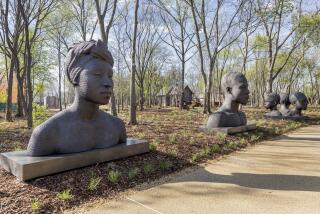Struggling to Tell a Slave Market’s History
- Share via
NATCHEZ, Miss. — It has been 140 years since the last slaves marched in shackles from brigs on the Mississippi River through this rowdy gambling city, to the bustling slave market a mile east.
At the Forks of the Road market, which by one historian’s account probably looked like “a sprawling prison camp,” they’d be haggled over and sold to cotton plantation owners who came from across the Deep South.
The river made for easy transport of slaves from the declining tobacco plantations near the Chesapeake Bay. On a knoll at the end of the Natchez Trace, an important route into Alabama and Tennessee, and Liberty Road, connecting Natchez to the Southeast as far as Georgia, the market’s position made for a natural meeting place.
At its peak, as many as 500 slaves could be found at the market on any given day. It’s believed to have been the second-largest slave market in the South; the biggest was farther down the Mississippi in New Orleans. The two biggest traders shipped more than 1,000 slaves from Alexandria, Va., to the two markets each year beginning in the 1830s. Trade at the Forks of the Road ended only with the Civil War.
Much of the history of the Forks of the Road was documented by Jim Barnett, a historian with the Mississippi Department of Archives and History.
Today, Barnett and other preservationists are trying to figure out just how to tell the slave market’s story.
After years of battles, the site of the infamous slave market was bought by the city with plans to turn it over to the National Park Service to include in the Natchez Historical Park. But that may take years and an act of Congress. For now, local preservationists are planning to create an interpretive center on the site within the next year.
That may not be easy.
“This is the next battleground -- that the true history goes up there and is not watered down,” said Ser Seshs Ab Heter-C.M. Boxley, a local activist who first began fighting for the site’s preservation about five years ago. “We’re not concerned whose toes we step on.”
Standing on the site, Boxley said the issue for him was nothing less than restoring humanity to his enslaved ancestors.
“This is sacred ground,” Boxley said. “Right here is where all those inhumanities and contrasts operated.”
The Forks of the Road was unique because slaves weren’t auctioned, but bargained over by individual buyers and sellers. A young male slave could be bought for about $500 in 1826, and as much as $1,600 in 1861, on the eve of the Civil War.
In Barnett’s account, written for the Mississippi Historical Society, he quotes New England writer Joseph Holt Ingraham, who visited the slave market in the 1830s. Ingraham described seeing a group of 40 slaves lined up in a semicircle to be inspected by prospective buyers.
“With their hats in their hands, which hung down by their sides, they stood perfectly still, and in close order, while some gentlemen were passing from one to another examining for the purpose of buying,” he wrote.
Boxley and Barnett are on a planning committee that will decide how eyewitness accounts such as Ingraham’s will be presented at the site. The committee has already decided to tell the story using a series of panels on the forced migration of the slaves, how business was done in the market, the connection between slavery and cotton, and the slave traders who profited from the sale of slaves.
The two biggest traders at the Forks of the Road and in New Orleans were Isaac Franklin and John Armfield. They discovered early the opportunities brought by the rise of cotton plantations in the South and the decline of tobacco plantations in the mid-Atlantic. They began to buy slaves cheaply and ship them over land and sea to the South. They built the Forks of the Road, which was already a traditional market that straddled the city limits, into a major slave market.
Today, a shuttered bar and a parking lot sit on the site. A marker at the intersection is the only evidence of what the land once was.
The committee is trying to fix that, first by applying to list the site on the National Register of Historic Places.
The committee may find its biggest challenge in working out the exhibitions’ language. Boxley, for example, opposes the use of the word “slave,” and prefers the term “enslaved person.”
Mimi Miller, director of preservation and education for the Historic Natchez Foundation and a member of the committee, said she doesn’t expect problems in planning the presentation.
She said she had toured Holocaust exhibitions in Germany, and what impressed her was that they left visitors with something positive. She said she would like the same effect with the Forks of the Road.
While the details still need to be hammered out, most agree that preserving the slave market will go a long way toward striking a balance in Natchez, where the main economic driver today comes from annual pilgrimages of tourists to the town’s sprawling antebellum homes.
“There seems to be some attitude of, ‘Why do you want to dredge up that stuff and bring all that unpleasantness back?’ ” Barnett said. “But Natchez has been criticized in the past for telling only one side of its history -- the side of the antebellum mansions and the white aristocracy.”
Boxley said that to accurately interpret the site, committee members will have to overcome the “Myth of the Lost Cause” -- Southerners still fighting the Civil War. That mentality, he said, has resulted in the repression of black history in Natchez, especially for the period of slavery.
Miller, though, said Natchez has done no better or worse than other places have in presenting black history, but that the town has gotten a bad reputation.
“Every house has an African American story, a white story, sometimes a Jewish story,” Miller said.
More to Read
Sign up for Essential California
The most important California stories and recommendations in your inbox every morning.
You may occasionally receive promotional content from the Los Angeles Times.










